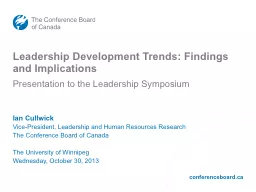

Presentation to the Leadership Symposium Ian Cullwick VicePresident Leadership and Human Resources Research The Conference Board of Canada The University of Winnipeg Wednesday October 30 2013 ID: 258087
Download Presentation The PPT/PDF document "Leadership Development Trends: Findings ..." is the property of its rightful owner. Permission is granted to download and print the materials on this web site for personal, non-commercial use only, and to display it on your personal computer provided you do not modify the materials and that you retain all copyright notices contained in the materials. By downloading content from our website, you accept the terms of this agreement.
Slide1
Leadership Development Trends: Findings and Implications
Presentation to the Leadership Symposium
Ian Cullwick
Vice-President, Leadership and Human Resources Research
The Conference Board of Canada
The University of Winnipeg
Wednesday, October 30, 2013Slide2
Agenda
Context - CEO Challenges and Strategies
Leadership Development – An Overview
Practices and Priorities
Learning and Development Outlook 2013
Implications and ConclusionsSlide3
Context - CEO Challenges and Strategies
CEO ChallengesSlide4
Context - CEO Challenges and Strategies
Human capital and leadership underpin four of the five top CEO strategies
CEO StrategiesSlide5
Unlike previous annual trends, CEOs are focused on operational and productivity-driven strategies.
Canadian CEOs are adopting a “small business owner” approach to their leadership and management styles – spending time on the front lines.CEO focus on building high-performance organizations that are efficient and engaged.
Growing talent internally is viewed as the number one human resources strategy for Canadian CEOs.
Context - CEO Challenges and StrategiesSlide6
A major Conference Board of Canada research initiative
Examines leadership priorities and practices across 14 industry sectors
Also identifies opportunities for improvement and better practices
A two-phased initiative – broader Canadian overview and “deep dive” into select practices
Leadership Development – An Overview
Leadership Development in Canada – A SnapshotSlide7
HR governance
Leadership capability and capacity
Succession planning
Talent management and engagement
Increasing growth
Leadership Development – An Overview
Like today’s global CEOs, Canada’s human resources leaders are clearly concerned with improving internal capacity and developing talent, particularly leadership talent.
Business Issues Driving Leadership DevelopmentSlide8
Leadership Development – An Overview
Many organizations have reduced or cut back their leadership development programs in response to fiscal challenges
Impact of Economic Environment on Leadership
Development Slide9
Practices and Priorities
Few Canadian organizations (39%) have a leadership development program for high potentials.
This has significant implications for succession planning and talent management.
Leadership Development Programs by Employee Segment
Source: The Conference Board of Canada.Slide10
Practices and Priorities
Overall Leadership Development Practices Use and Effectiveness
T
he leadership development activities perceived to be most effective are not necessarily the ones that are used most often.
Source: The Conference Board of Canada.Slide11
Practices and Priorities
Opportunities for High Potential Development
Organizations are not using the most effective development activities for high potentials: Stretch Assignments, Planned career assignments, and Coaching.
Source: The Conference Board of Canada.Slide12
Practices and Priorities
Opportunities for Executive Development
Largest opportunity gaps for leadership development at the executive level: Job rotations, Facilitated leadership conversations, Coaching, Action learning and Planned career assignments
Source: The Conference Board of CanadaSlide13
About the LDO:
The 12th edition of the
Learning and Development Outlook
A total of 198 organizations completed the survey
Provides an overview of the current state of learning and development practices and programs across Canada
Learning and Development Outlook 2013Slide14
Creating and maintaining a strong learning culture
Ensuring that learning is a top priority
Offering diverse learning delivery
Providing learning supports
Aligning learning with organizational strategy
Learning and Development Outlook 2013
Key Drivers of a Stronger Learning EnvironmentSlide15
Creating and Maintaining a Strong Learning Culture
Prioritize learning
Align learning with organizational objectives
Promote/Support the delivery of diverse learning methods
Have strong leadership support for learning
Learning and Development Outlook 2013
Organizations were categorized into weak, moderate and strong learning cultures based on survey responses to key drivers of learning culture.
Learning culture is comprised of key factors that address the degree to which organizations:
Source: The Conference Board of CanadaSlide16
Learning and Development Outlook 2013 Effectiveness of Leadership Development Practices
In 2012, only 32 per cent of organizations rated their leadership development practices as effective.
Source: The Conference Board of CanadaSlide17
Learning and Development Outlook 2013
Organizations with strong learning cultures are far more likely to have effective leadership development practices.
Effectiveness of Leadership Development Practices by Learning Culture
Source: The Conference Board of CanadaSlide18
Learning and Development Outlook 2013
Organizations with effective leadership development practices rate their performance as superior to their competitors across all organizational performance areas.
Organizational Performance Relative to Competitors, by Effectiveness of Leadership Development Practices
Source: The Conference Board of CanadaSlide19
Learning and Development Outlook 2013
Organizations with strong overall leadership performance rate their organization as superior to their competitors across all organizational performance areas.
Organizational Performance Relative to Competitors, by Overall Leadership Performance
Source: The Conference Board of CanadaSlide20
Strong leadership is critical for organizational performance
Organizations are not confident that current leadership development practices are effectiveWhile succession planning is a key driver of leadership development, high potential employee identification and development is not a top priority for many organizations
Effective leadership development requires an integrated approach to learning, development and talent management
Conclusions and ImplicationsSlide21
Implications and Conclusions
Senior executives
0.44
Executives
0.70
Management
0.47
Mission critical positions
0.35
Source: The Conference Board of Canada.
Ratio of high
potential successors to positions
Succession Planning Slide22
Source: Centre for Creative Leadership, “Blended Learning for Leadership: The CCL Approach,” 2013, 2 and 5
.
Blended Strategy for Leadership Development
90% of development is informal
Implications and ConclusionsSlide23